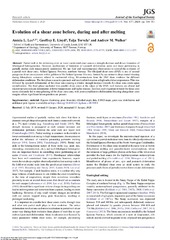Evolution of a shear zone before, during and after melting
Permanent lenke
https://hdl.handle.net/10037/20564Dato
2020-03-03Type
Journal articleTidsskriftartikkel
Peer reviewed
Sammendrag
Partial melt in the deforming mid- or lower continental crust causes a strength decrease and drives formation of lithological heterogeneities. However, mechanisms of formation of syn-melt deformation zones and strain partitioning in partially molten rock remain poorly understood. We use field and microstructural observations to unravel the evolution of a partial melt shear zone, Seiland Igneous Province, northern Norway. The Øksfjord shear zone (ØSZ) is one of several paragneiss shear zones present within gabbros of the Seiland Igneous Province, formed by syn-intrusive deep crustal shearing during lithospheric extension related to continental rifting. Microstructures from the ØSZ show evidence for different deformation conditions. The first phase was active pre-melt and involved deformation at high subsolidus temperatures. This was followed by syn-melt deformation of the shear zone causing a relative strength increase towards the shear zone centre upon crystallization. The third phase nucleated two parallel shear zones at the edges of the ØSZ; melt textures are absent and microstructures indicate deformation at lower temperatures and higher stresses. In effect, melt migration towards the shear zone centre ultimately led to strengthening of the shear zone core, with post-crystallization deformation focusing along shear zone margins where significant heterogeneities are present.
Forlag
Geological Society of LondonSitering
Lee AL, Lloyd, Torvela, Walker AM. Evolution of a shear zone before, during and after melting. Journal of the Geological Society. 2020;177:738-751Metadata
Vis full innførselSamlinger
Copyright 2020 The Author(s)


 English
English norsk
norsk